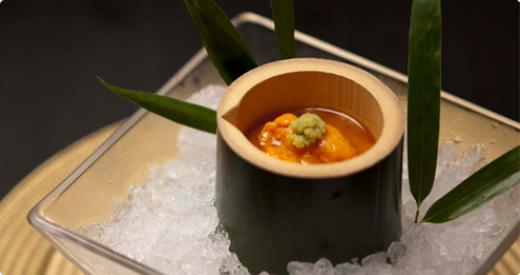
Known as the foremost Chinese chef in Japan, Chef Yuji Wakiya broke new ground in the culinary world with the concept of Haute Chinese. With an extensive career as an executive chef, Chef Wakiya launched Wakiya in Akasaka, known as one of the most popular Chinese restaurants in Japan. Chef Wakiya has taken his success to a global level with the opening of Wakiya at The Gramercy Park Hotel in New York. Most recently, Chef Wakiya held a Culinary Masterclass at the 2011 World Gourmet Summit in Singapore earlier this month.
In David Bouley’s latest book, Haute Chinese Cuisine From the Kitchen of Wakiya, he describes Wakiya’s cooking as “A step beyond what we think of Chinese cuisine, in terms of the balance of flavors, thoughtful combination of ingredients and flawless execution of its techniques.”
In Wakiya’s own words, he states “I am going to set my imagination free, combine many unique ingredients, and create my own original dishes.”
AP: Asian Palate YW: Chef Yuji Wakiya
AP: People remember you as the revolutionary who changed the way Chinese cuisine is served in Japan. You‘ve recreated Chinese food into small, individual servings in elegant setting. What inspired you to do this and how would you classify and define your style of cooking?
YW: I was inspired by my experiences in Chinese restaurants during my twenties. At that time, the portions were quite large, making it difficult to enjoy a “full course” meal for one or two people. My response to this was to create individual servings in an elegant presentation, hoping it would become popular with my customers. My cooking style is a combination of traditional and creative elements.
AP: There is a strong focus on Japanese ingredients like konbu (Japanese kelp), kurobata belly, gobo (Japanese burdock) in your upcoming Singapore World Gourmet Summit 2011 masterclass, are these ingredients seasonal or available year-round?
YW: All of these ingredients are available year round. Konbu is widely used in Japanese cooking, however, some varieties are more valuable because they are specially cultivated. The kurobata belly I have chosen is all 100% purebred Berkshire pig. I will also be serving the gobo as a pickled dish.
AP: What are the seasonal Asian ingredients that inspire you the most? What are the most interesting Japanese ingredients you like to use today? Was it different 10 years ago?
YW: The different vegetable varieties that are available seasonally inspire me to create new dishes. Lately, I have been incorporating konbu into a lot of my dishes.
AP: Beyond dashi and umami, there is this new 6th term kokumi that is interpreted as “a richness, or a fullness, in-the-mouth type of perception”. Do you think kokumi will form part of the heart of Japanese cuisine?
YW: Kokumi is a new term in Japanese cuisine, more commonly expressed as koku. Koku has a similar meaning to umami. Both interpretations describe a combination of different elements that come together and create a savory taste.
AP: As you told us koku is similar to umami, can you tell our readers how to identify these two tastes? Can you name us a dish that can express koku very well?
YW: The difference between the two is that umami refers to sweet, sour, salty and bitter flavors that come together and create a well-balanced taste. There are many different kinds of food and dishes that contain umami such as mushrooms, tomatoes, certain types of fish, and pork. Soy sauce, fish sauce, different kinds of stock and miso are also considered to have the umami element.
Koku describes a harmony of several ingredients, sweet, salty, also encapsulating the umami element, creating a rich, full and hearty flavor. The koku flavor is best used for meat dishes that involve curing, braising, or roasting.
AP: Will you be writing another new book after various impressive publications (latest being Haute Chinese cuisine from the Kitchen of Wakiya)? Any new angles or directions?
YW: I don’t have plans for a new book at the moment but I do plan on writing another book in the future.
AP: Lastly, will you be opening new restaurants in Asia? Would you consider establishing your own culinary school to educate young Asian chefs?
YW: Opening a new restaurant or establishing a culinary school are not in my plans right now. However, I am very interested in staying engaged with culinary world of Asia and I hope to keep an open channel of communication with those in it so we may all be inspired by each other.









